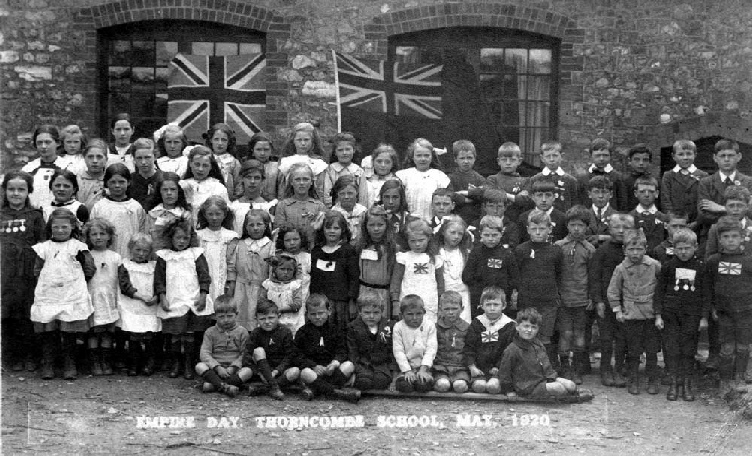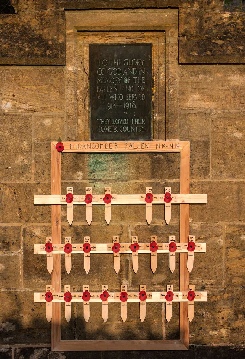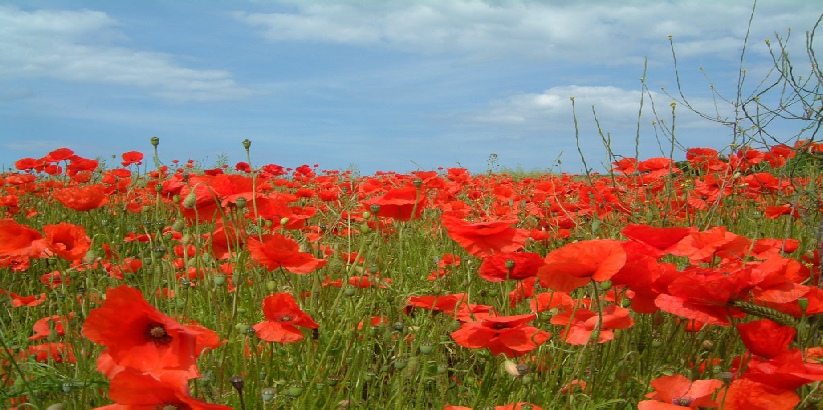





The men of Thorncombe who died in the First World War
‘We shall remember them’
Compiled by Heather Roughton, November 2018, to mark the 100th anniversary of the 1918 Armistice.
With acknowledgements to Ron Farley’s Millennium Book of Remembrance for the Birdsmoorgate Branch of the Royal British Legion, 2001.
Arthur George DOWN Died Sunday 29th August 1915 aged 20.
His father Albert was a native of Thorncombe, who for a time after his marriage was landlord of the Golden House Inn at Holditch (1891 census). By 1911 the family lived at Schoolhouse, and Albert had a haulage business. Arthur and his brother Albert jr were both farm labourers in peacetime, but joined the Royal Navy. He was one of 7000 sailors based at Devonport who died during the First World War.
Albert William DOWN, died on 30th September 1918.
He left a wife, Ethel living in Taunton -
Archibald Stoodley EBDON
Archie died aged 39 years old on 4th October 1917 during the third battle of Ypres . He was serving in the 1st Battalion, Devonshire Regt. He is commemorated on the Tyne Cot Memorial at Zonnebeke in Flanders 9 km NE of Ypres, one of 35,000 names of those with no known grave who died in the Ypres salient.
He was a mason , like his father Sam, who brought the family up in Fore Street. Born in 1878, he married around 1900 but his wife died 6 months after the marriage. At the time of the 1901 census he was boarding with his older brother in Blackwood, Monmouthshire
Oliv er Fran cis EB DON
Brother of Archie. Ollie served in the 2nd Battalion, Welsh Regiment, which landed at Le Havre on 13th August 1914 as part of the British Expeditionary Force. He died of wounds on Saturday, 26th September 1914, and is buried in France.
Fifth child of Sam and Christiana Ebdon, and also a mason like father and his brothers. He was born in 1884 in Fore Street, and in 1909 married a London girl, Rose, and brought her and her two babies to live at his parents’ home. Rose later moved to live in Monmouthshire where other members of the Ebdon family appear to have been living. She remarried, living in Thorncombe Road, Blackwood, Monmouthshire.
Robert EBDON
Robert was not a brother of the two Ebdons already listed, but was possibly a cousin. His mother originated from London. She was a widow at the outbreak of the war living two doors away from Sam and Christiana Ebdon. Three of her five sons were serving in the Army. Robert was her third son, just 17 when the war started, and worked at Sadborow as a garden boy from leaving school. He had been a choirboy in St Mary’s , and afterwards operated the organ bellows for services. He joined up in the summer of 1915.
He died aged 19 on the first day of the Battle of the Somme, alongside his colleagues of the 8th Battalion Somerset Light Infantry. A memorial service to honour him was held at St Mary’s at the end of July 1916. He is buried in the cemetery near Ovillers/La Boisselle, originally known as `Sausage Valley’ cemetery, with 150 other First World War casualties.
Jack FORSEY
Jack died in action in Gallipoli on 21st August 1915, aged 28, and his death was reported in the Bridport News. He was one of three brothers serving in the forces, and left also a sister Rose and his mother Mary living on Fore Street. Jack joined the Queen’s Own Dorset Yeomanry soon after the outbreak of war, as servant to 2nd Lieut Owen Bragge of Sadborow, the son of Thorncombe’s vicar. He had previously worked for the vicar, the Rev Canon Bragge and was a regular attendant at church. A memorial service was held for him at Thorncombe in September 1915, and a brass plaque on the north wall of the nave commemorates him.
Albert Edward FRENCH
Was a gunner in the Royal Field Artillery and died in Northern France on 9th April 1917 aged 27. He is buried near Arras. He was brought up in Thorncombe in Fore Street, the second son of John and Ellen French and in peacetime had worked as a coachman. In the summer of 1916 he had married Ellen Rockett, the housemaid at Greenhill.
George Herbert FROOM
Was born in Hewood but by the outbreak of war was living with his parents, 3 brothers and sister at Schoolhouse. Like the Down brothers, two other young men of Schoolhouse, he became a stoker in the Royal Navy. He died at sea on 15th July 1917, one week before his 24th birthday. He is buried in the churchyard alongside the pathway that leads from the porch.
Fred HAWKER
Fred was one of four boys, and was brought up in Hewood. He joined the Army in 1905 at the age of 18, and served as a regular soldier in the 1st Battalion Somerset Light Infantry. We learn from his enlistment record that he was only 5’ 3”. His Battalion landed in France on 22nd August 1914, as part of the British Expeditionary Force. Fred was killed in action 4 days later in the Battle of the Marne, as the Germans swept through Northern France and threatened Paris. He was 26 years old, the first Thorncombe boy to die in the War. He is commemorated in a Memorial garden alongside the main road to Paris, on the south bank of the River Marne, together with 4000 men of the BEF who have no known grave.
Robert HAWKER
Robert worked on the local farms, until he joined the Army. His parents were Hugh
and Annie Hawker of Thorncombe, but his father died when he was only 6. In 1901
there were seven children living with Annie at Knapp Cottages. In 1910 Annie remarried
-
Robert died aged 25 serving in the 6th Battalion of the Somerset Light Infantry on
the first day of the German Spring offensive in March 1918 which is known as the
battle of St Quentin, when the British front-
Fred HEMBURY
Died on 28th August 1917, aged 21 in the Ypres Salient in what is known as the Battle of Passchendaele, which lasted from July to November 1917. The start of August that year saw unprecedented levels of rainfall, day after day, and the troops were bogged down in a sticky morass. Fred has no known grave and is commemorated on the Tyne cot Memorial. His parents John and Mary lived at Knapp Cottage, and Fred was one of six children. They lived next door to Robert Hawker whom we commemorated at our last service.
Ben HODDER
Ben was 25 when he was killed in action in Flanders, serving with the Devonshire
Regiment. At the time of Ben’s death, his father was a widower living alone at Shedrick.
The family had previously been at Manor Farm in Winsham, but his mother was born
at Holditch When Ben enlisted in Exeter, he gave his residence as Chard as he
was working as boot-
Lambert George HUSSEY
Hussey had served in the Devonshire Regiment during the war, and survived the hostilities. He died at Exeter (possibly in the flu epidemic) in February 1919, while still in uniform with the 44th Home Service Labour Corps. Hence he is one of the few on our Roll of Honour whose remains are actually buried in the churchyard here. His parents originated from Hawkchurch, but were living at Schoolhouse prior to the war. He had an elder brother Reginald, and also an older sister. Both boys were employed at Schoolhouse farm.
Alfred Charles LANGFORD
Albert Langford was born in Thorncombe in 1880, one of seven children. His father Thomas, also born in Thorncombe, was a thatcher. The family lived at Gough’s Barton when they were growing up. Alfred the second son became a farm labourer, and when war came he was 34, living at Templeman’s Ash, Birdsmoorgate, with wife Florence and their four children He enlisted in the Royal Field Artillery at Bridport but was later transferred to the 34th County of London Battalion as a rifleman. He died of wounds in Belgium in the final weeks of the war, aged 38, two years after the death of his younger brother who died of wounds in 1916 (see below). His widowed mother was then living a Higher Gribb.
Levi LANGFORD, the third of the Langford boys brought up at Gough’s Barton, died of wounds on the Western Front in December 1916 while serving with the Royal Garrison Artillery. The Vicar noted his death in the parish magazine, commenting that he had moved from the parish some years before. Levi had moved around the county for work. In 1905 he married a Devon girl, and they had two little girls. The family were living at Parkstone near Poole by the outbreak of war. His widowed mother and two sisters were living at Higher Gribb.
Albert Henry LOUD
B. 1891 in Thorncombe. During the war he served in an agricultural company of the Labour Corps which was only formed in 1917 when Regimental agricultural companies were merged into the labour corps. He died of flu in the military hospital at Croydon a month after the end of hostilities, in December 1918. He is buried in Thorncombe churchyard together with his father, Eli Pinney Loud, who lived at Hewood Farm .
Albert appears to have moved around relatives as he grew up, e.g. in 1901 he and his mother were at her sister’s home in Islington, and in 1911 he was working for another uncle on his farm. On his death certificate he has a London address and is described as a printer’s assistant.
Frederick MOREY
Fred died in August 1917 during the Third Battle of Ypres. He was 34 when he died, and before the war had been employed as a coachman (possibly at Sadborow ) and lived at Wynyards Farm, with his widowed mother, Elizabeth, and his older brother George. The family had been brought up in Hardington Mandeville , where their father worked as a tailor in his home village until his death in 1895.
Leonard MOREY
A younger brother of Fred Morey, Len was a regular soldier serving with the 2nd Battalion of the Coldstream Guards. The Battalion was sent to Ypres on 20th October 1914, and the following day was involved in an attack in the Languemark area when eight men were killed. Len was 28 when he died, and his name appears on the Menin Gate memorial, commemorating those with no known grave.
Gerald Fitzroy QUICK
Gerald was born in 1893 at Ashcombe Farm, Wayford. The family of two girls and six boys, moved to Grange Farm, Thorncombe after their parents’ death, and all worked on the farm in various capacities. Gerald enlisted at Bridport as a gunner in the Royal Garrison Artillery, and was killed in action in France in late September 1918. He is buried near Cambrai in France.
Samuel WELCH
Sam was the third son in a farming family from Ilminster and enlisted in December 1914, joining the 12th Service Battalion of the Somerset Light Infantry. In the spring of 1918 he married Violet Beadle of Easthay Farm. The battalion was sent overseas on 25th September; a day after his baby son Reginald John was born. Sam was killed in action shortly afterwards on 11th October 1918, while on patrol during the battle to take Aubers village, aged 23. He is buried in the war cemetery at Aubers Ridge near Lille in Northern France.
Frederick Ullathorne WOOLNOUGH
Frederick Woolnough was born in York in 1882. He trained as an elementary schoolteacher, and was appointed headmaster of Thorncombe School in 1911 aged 28. He and his wife would have lived in the house opposite the church gates, which until 1973 was the site of the school. When he was called up in March 1915, his wife Edith took over at the school. (She was also the church organist).
Fred Woolnough became an officer in the Dorsetshire Regiment. This Regiment never saw service on the Western Front, but Capt Woolnough was attached to the 6th Battalion of the Somerset Light Infantry . On 22nd March 1918 (2 days before Palm Sunday), Capt Woolnough died of wounds as British forces fought the German Spring advance. He is buried in the military cemetery near the village of Ham, which was close to a Casualty clearing station. He was 35 years old.
The 6th Som LI was virtually wiped out in the battle for St Quentin – only 4 men making it back to Brigade headquarters. The Battalion diary records that there were an estimated 20 officers and 540 other ranks lost or wounded in the attack on the 21st. Robert Hawker ,another Thorncombe man serving in the 6th battalion, died on the battlefield during the attack. Fred Woolnough died of his wounds the following day. Total Casualties for the British forces on 21st March were 32,000.

| Membership |
| History of the Trust |
| Committee |
| Constitution of the Trust |
| Minutes of meetings |
| Archived Minutes |
| Contacts |
| Newsletter |
| Past Events |
| 20th Anniversary |
| Clapton Mill tour |
| Rock pool search |
| Photo exhibition |
| Nature Diary |
| Trees |
| Commemorative Trees |
| Johnson's Wood |
| Plants and Flowers |
| Geology and geography |
| Wildlife |
| Birds |
| Chard Junction Nature Reserve |
| Nature Reserve pictures |
| Butterflies |
| Butterfly survey |
| Photo albums |
| Artists and writers |
| Footpaths |
| General |
| Poor relief |
| Houses |
| In the news |
| Industry |
| Pubs |
| Religion |
| Reminiscences |
| Schools |
| 17th and 18th centuries |
| Harry Banks |
| Pissarro |
| Hedge Dating |
| Once upon a Thorncombe Road |
| Thorncombe's History |
| The poor |
| Workhouse |
| Chard St Bakery & Forge |
| Holway Cottage |
| Forde Abbey |
| Gough's Barton |
| Holditch Court |
| Upperfold House |
| Sadborow Hall |
| Wayside |
| Dodgy local ice-cream |
| Gribb arsenic poisoning |
| Industrial relics |
| Westford Mill |
| Broomstick Weddings |
| Royal Oak |
| Golden House |
| St Mary's Church |
| Thorncombe's Chapels |
| Quakers |
| Commonwealth vicars |
| Who was William Bragge? |
| Hewood |
| Donald Hutchings school |
| Donald Hutchings wartime |
| Louise May Silver |
| Starting out in 1960s Thorncombe |
| Village Life in the 1980's |
| Wilfred Potter |
| Holditch memories |
| St Mary's School |
| Forgotten epidemic |
| Jacobites |
| Thorncombe Market |
| Walk 1 |
| Walk 2 |
| Walk 3 |
| Walk 4 |
| Walk 5 |
| Walk 6 |
| Walk 7 |
| Rights of Way information |
| History of the Trust |
| Constitution of the Trust |
| Minutes of meetings |
| Archived Minutes |
| Obituaries |
| Contacts |
| Newsletter |
| Newsletter Archives |
| Past Events |
| Blackdown Walk Aug 2013 |
| Bluebell Walk May 2013 |
| Pollinator Survey June 2013 |
| Visiting new-born lambs 2013 |
| 2014 Christmas Sale |
| Trees |
| Commemorative Trees |
| Johnson's Wood |
| Geology and geography |
| Wildlife |
| Birds |
| Chard Junction Nature Reserve |
| Nature Reserve pictures |
| Butterflies |
| Butterfly surveys |
| Photo albums |
| Artists and writers |
| Footpaths |
| General |
| Poor relief |
| Houses |
| In the news |
| Industry |
| Pubs |
| Religion |
| Reminiscences |
| Schools |
| 17th and 18th centuries |
| Harry Banks |
| Pissarro |
| Hedge Dating |
| Once upon a Thorncombe Road |
| Thorncombe's Lost Roads & Hidden Holways |
| Thorncombe's History |
| First World War Thorncombe men |
| Thorncombe's Changing Boundaries |
| Parish Poorhouse and Workhouses |
| The poor |
| Life in Thorncombe's Workhouse |
| Chard St Bakery & Forge |
| Holway Cottage |
| Forde Abbey |
| Gough's Barton |
| Holditch Court |
| Upperfold House |
| Sadborow Hall |
| Wayside |
| Thomas Place and The Terrace |
| Pinneys |
| 1 & 2 Church View Chard Street |
| Dodgy local ice-cream |
| Gribb arsenic poisoning |
| Industrial relics |
| Westford Mill |
| Thorncombe's Flax and Hemp Industries |
| Broomstick Weddings |
| Royal Oak |
| Golden House |
| St Mary's Church |
| Thorncombe's Chapels |
| Quakers |
| Commonwealth vicars |
| Who was William Bragge? |
| Holditch memories |
| St Mary's School |
| St Mary's School photos |
| Forgotten epidemic |
| Jacobites |
| Walk 1 |
| Walk 2 |
| Walk 3 |
| Walk 4 |
| Walk 5 |
| Walk 6 |
| Walk 7 |
| Walk 8 |
| A Village Walk. Walk 9 |
| Walk 10 |
| Rights of Way information |